AOC’s updated double-wide AG493UCX2 could appeal to some, but there are too many incompatibility issues for it to be a solid recommendation
- Manufacturer: AOC
- Model: AGON AG493UCX2
- Type: DQHD Ultra-wide (5120×1440 – 32:9) VA Gaming Monitor
- Price when reviewed: £979.49 (MSRP)
- Supplied by: AOC
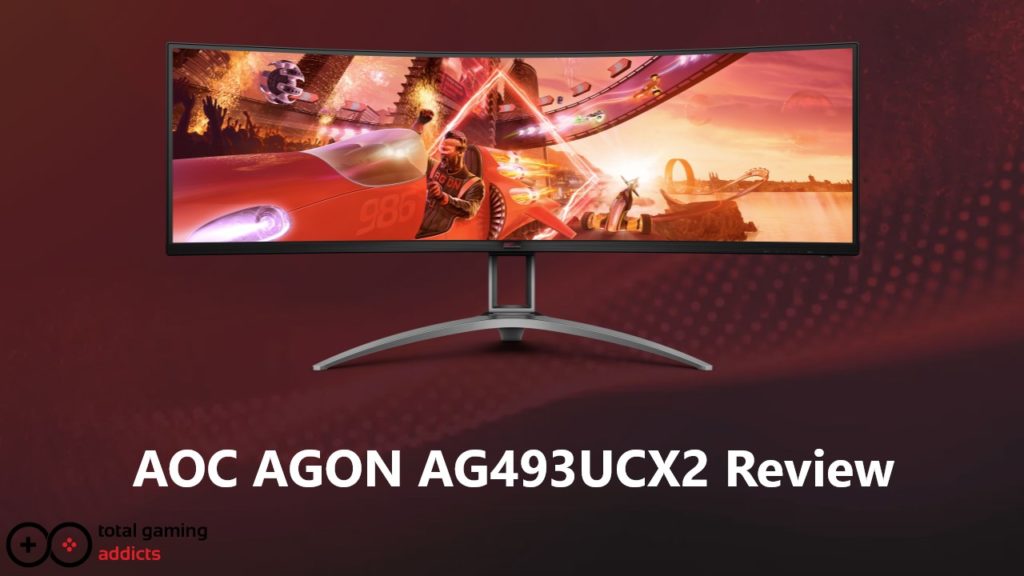
AOC AGON AG493UCX2 Review
The AGON AG493UCX2 is a massive 49” double-wide (32:9) gaming display with a resolution of 5120×1440, which makes it the equivalent of two 27” QHD monitors. Aside from ultra-wide gaming, it’s very well suited for productivity, and there’s ample space for multiple apps and browser windows to be open simultaneously, as well as supporting PBP if you regularly work with two (or more) systems.
My track record with AOC’s range of monitors has been very good, but I had mixed feelings about the AG493UCX2. This is despite it having the improvements I wanted in comparison with the previous model. That’s not to say it’s a bad monitor, as there are many things it does exceptionally well, but equally, there are areas that let it down, including steps back from the AG493UCX.
We’ll start with the good;
Gaming on this behemoth of a display is stonkingly good fun, especially if you have a GPU capable of propelling the AG493UCX2 to its max refresh of 165Hz. The 1800R curved display completely fills your field of view, giving you a commanding view of your surroundings. It comes into its own when you’re admiring scenic landscapes, and if you’re a fan of driving games but don’t have space for a triple-screen setup, this strikes a superb middle ground that gives you the peripheral view you otherwise miss on single monitors and even 21:9 ultrawides.

This double-wide aspect ratio is superb for general work and entertainment, too. I routinely use two screens anyway, so I’m used to having the extra screen space to work with, but you aren’t hampered by a separating bezel in the centre, giving you far more flexibility in window sizing and placement. It’s also great if you watch a lot of movies and TV shows that are filmed in a wide aspect ratio.
The display itself is brilliantly bright and vivid, peaking at over 600 nits, and because it’s a VA panel, the contrast is visibly better than most IPS alternatives. Colour accuracy has seen a significant improvement, too, with an average DeltaE of just 0.68 in sRGB mode (compared to 1.6 on the AG493UCX).
An issue I had with the previous model was that the maximum resolution could only be achieved when using DisplayPort connections. The AG493UCX2 now allows you to reach the full resolution via both HDMI and USB-C (DP alt mode) connections, albeit at reduced refresh rates. There are some caveats to this, though, which we’ll cover in more detail later.
Now, unfortunately, it’s time to address the negatives;
PBP is, in my opinion, essential for a monitor of this size, and it almost works flawlessly. You can seamlessly switch between multiple connected devices, and the KVM switch makes using multiple systems a breeze. A major downside, though, is that when using USB-C connections the display gets letterboxed (see image below). Manually changing the resolution didn’t help, either, as switching the laptop output to 1440p also added black bars at the sides, too. USB-C issues aside, PBP is still a welcome function, and I can’t rule out that it was an issue with hardware at my end, but no amount of testing and experimentation could resolve this.
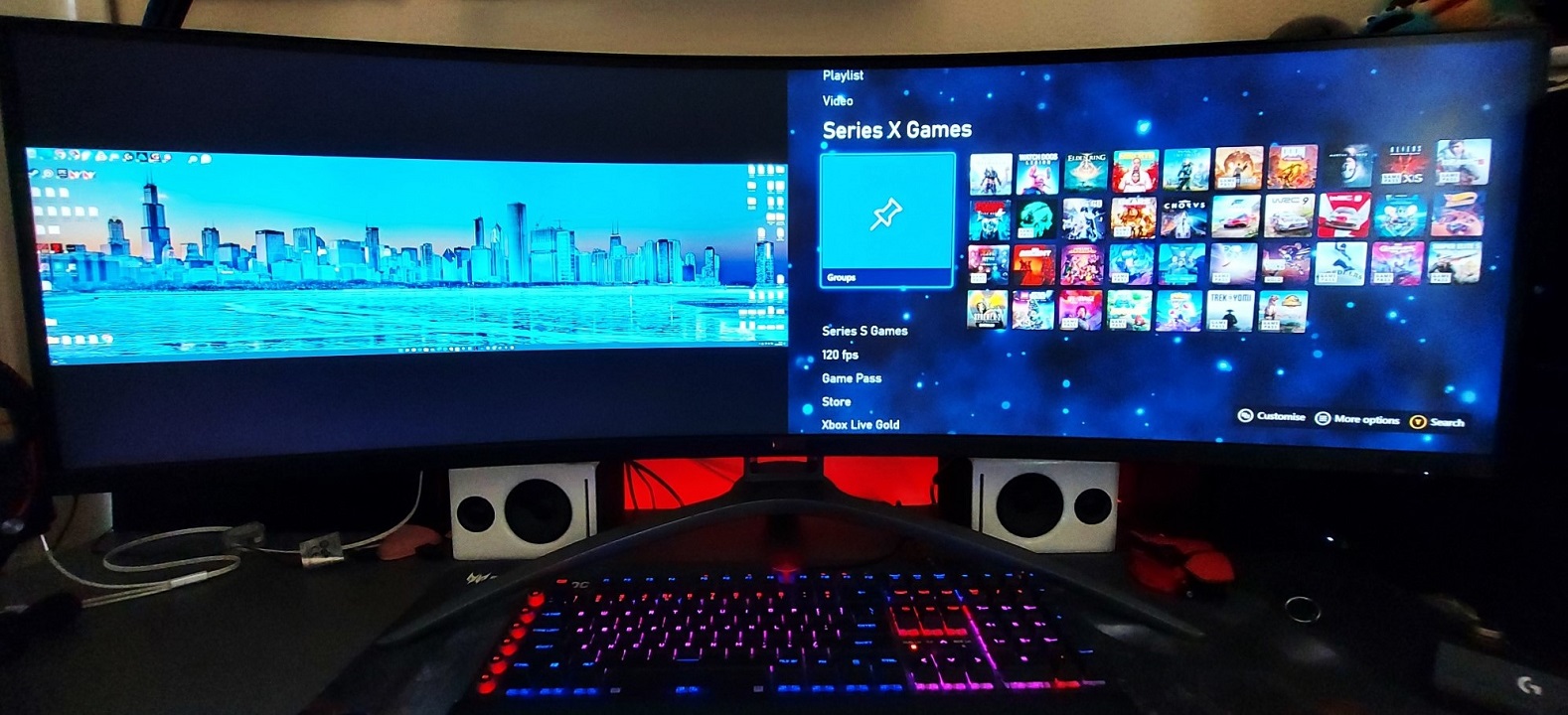
The AG493UCX2 is hit-and-miss when it comes to consoles. Sometimes it stretches the image across the whole display, regardless of the resolution and combination of settings used. On the old model, you could access the image ratio settings and change it to a 27” 1440p resolution, which added black bars on either side of the image, but it was displayed at the correct resolution without unwanted scaling. In the beginning, I couldn’t resolve this at all, but then, out of the blue, the image ratio settings became available.
Unfortunately, this was short-lived, as the next time I fired everything up, I had a stretched image and no ratio settings available. Eventually, I worked out you could flick to a PC on one of the other ports, switch the monitor to 27” W(16:9) image scaling, then back to the console, and it was fine; obviously, this is a huge pain in the backside.
You also cannot display native 1440p at 120Hz on the Series X, as it restricts the max resolution to 1080p if you want to play at 120Hz. This surprised me, as even with an HDMI 2.0 connection you can run 1440p 120Hz on other AOC displays. So yes, you can use the AG493UCX2 for consoles, but it’s not as seamless as you would have hoped.
Consoles work perfectly when using PBP, but HDR cannot be used in PBP mode, and there is also no HDR compatibility at all in USB-C (DP alt mode).
Another constant niggle I had was when switching display inputs, as it takes a painfully long time to switch, often in excess of 12 seconds. I also had issues with the AG493UCX2 not switching on automatically with an HDMI source. It can take over 20 seconds to activate the screen from standby (compared to 1 to 3 seconds with most other AOC panels), which makes it frustrating when it doesn’t turn on at all, as you have to wait just in case it’s dragging its heels.
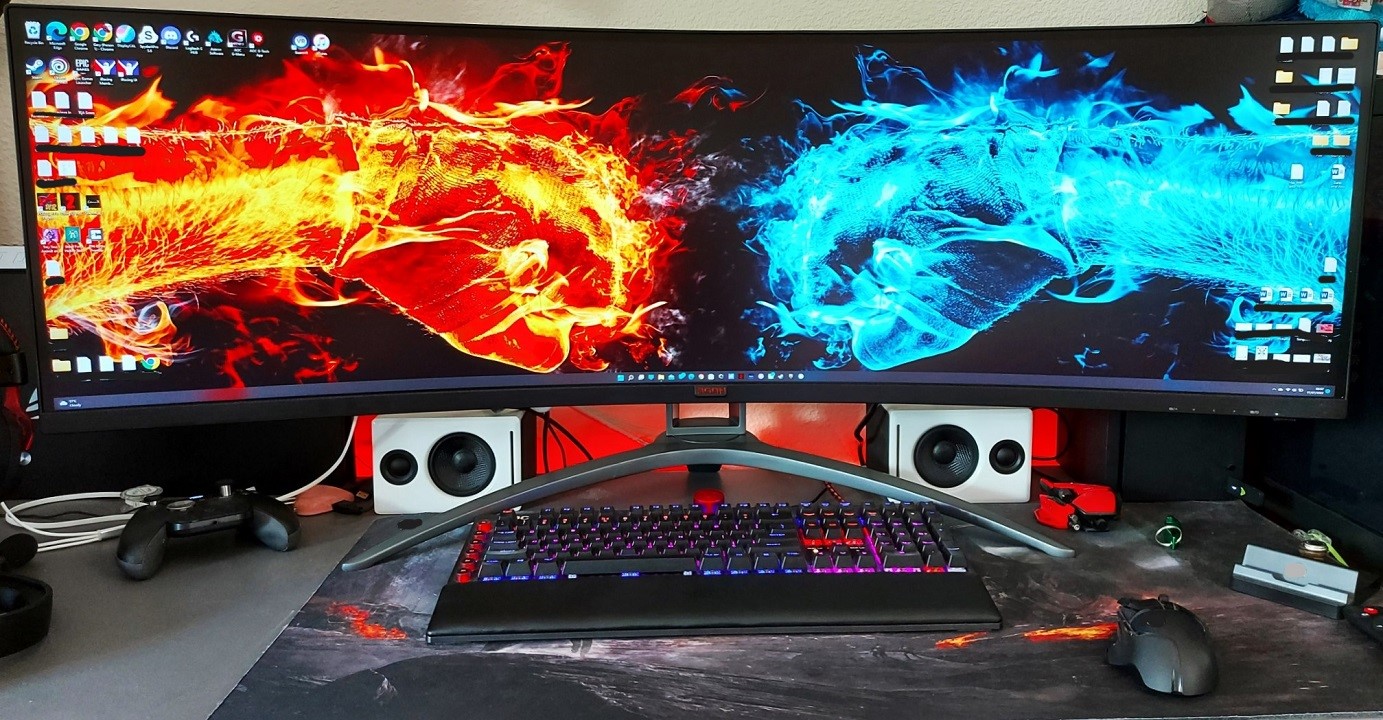
Although improvements have been made to resolution and frame rates when using HDMI and USB-C display connections, the AG493UCX2 still only works at its best when using DisplayPort. This is mildly disappointing, as this kind of double-wide monitor is likely to appeal to people with multiple devices looking for an alternative to having two separate monitors on their desk. The potential is there for the AG493UCX2 to be a superb multi-use monitor, but until parity can be achieved across all display connections it’s harder to recommend without caveats unless you use DP 1.4 from your GPU.
For those of you who solely want to connect a single PC via DisplayPort, a lot of the issues with this monitor are moot, and I can’t stress enough how awesome it is playing mega-wide games. This huge display also has great colour and contrast, and the bump up to 165Hz makes a big difference to smoothness and the handling of motion blur and VA smearing, which can be more pronounced at lower refresh rates.
Most monitors have a specific target audience, but the AG493UCX2 is more niche than most, as not only do you need a capable GPU (RTX 3070 or better, ideally), but you also need a desire to play ultrawide games or to have a use for the extended screen real estate. If this describes you, the AG493UCX2 is a compelling option, and it’s reasonably priced for what it is.
Design and build
Inside the box, you get a 1.8m DisplayPort cable, a 1m USB-C cable, a USB-B upstream cable and a 1.8m HDMI cable. As we are in the UK, we also got a 3-pin plug on the end of the 1.8m power cable, and because the power adapter is integrated, there is no unwieldy power brick to contend with.
The stand comes fully assembled, but rather than just clipping into the panel there are four screws to secure it in place. On our review sample, the holes didn’t line up properly, so I had to screw them in at a slight angle. As they tightened they pulled into line, but it’s a rare bit of sub-par build quality that I don’t expect from AOC. The misaligned screw holes are the only negative I can attribute to the build, though. Everything else is pristinely manufactured, with close-fitting panels and a reassuring heft that feels distinctly premium.
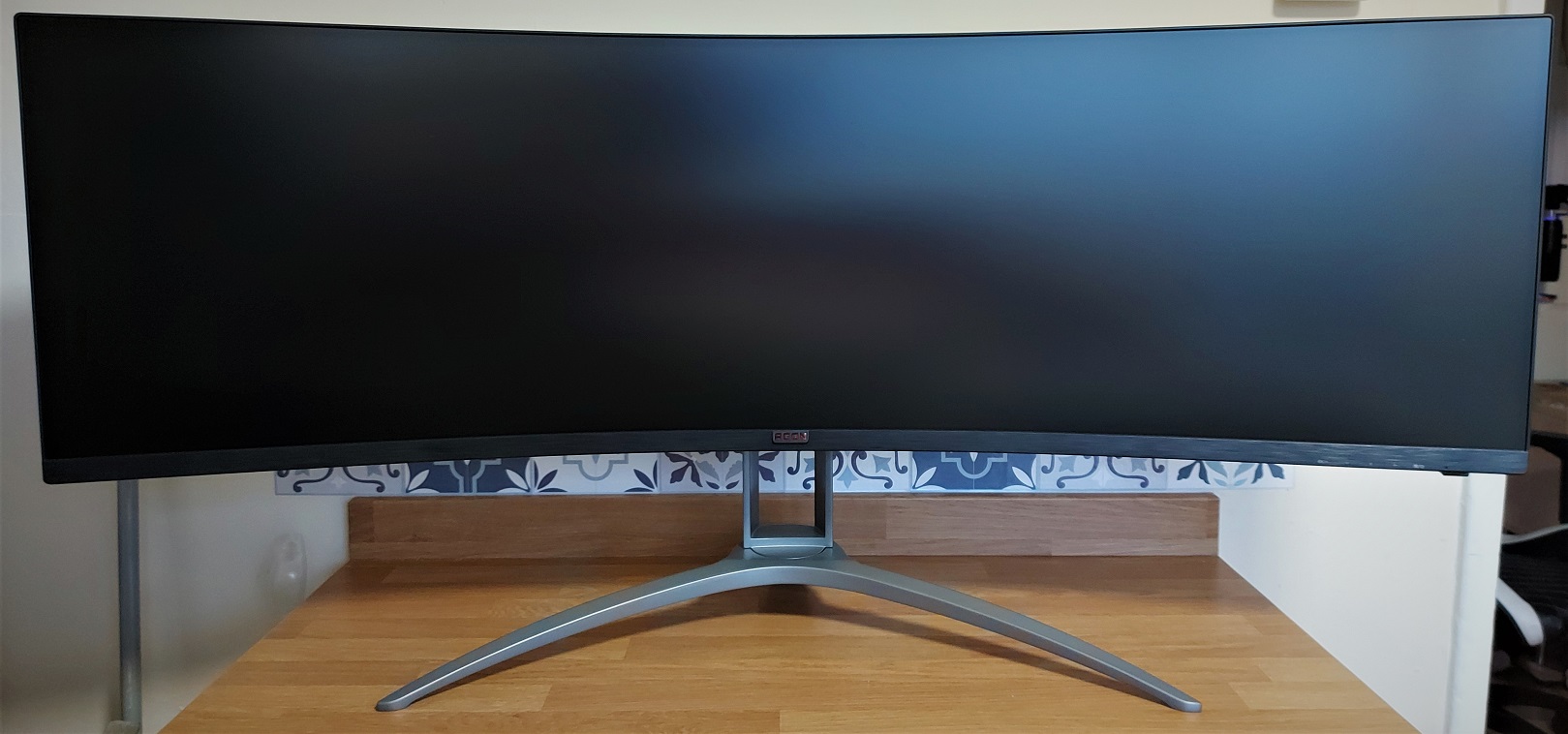
Aesthetically, there’s no difference between the older AG493UCX and the new model. The styling is clean and modern, with no RGB or “gamer” features, which means the AG493UCX2 wouldn’t look out of place in a professional environment. Bezels are suitably slim, and although the screen is flanked by a slightly larger border, it’s within the realms of what we’ve come to expect from plus-sized displays.
The chunky all-metal stand is very robust and stable, and although the footprint is very wide, AOC has kept the depth in check and it doesn’t protrude too far onto your desk, with space between the legs for a full-size keyboard. This is an impressive achievement given the sweeping curves of the massive display. Ergonomic adjustments are limited in comparison to a regular monitor, but for a big-screen display, it’s more than what you’d typically expect. The height can be adjusted 100mm, as well as tilted -3.5°/+13.5° and swivelled +/-15.5°. It’s also Vesa 100 mount compatible, though you’ll need a sturdy stand.

I was happy that AOC included a remote, as the small buttons on the underside of the display are a lot less practical than a mini-joystick, though they are more clearly labelled than on some of AOC’s other displays. They have improved the buttons, however, and they have a reassuringly solid click without the loose spongy feel of some of AOC’s cheaper displays.


The remote allows you full access to the OSD menus, but it also has quick access controls for selecting the source, brightness and volume, as well as a power button for turning off the display. On the previous model, the button between the volume up and down served as a convenient mute switch, but for some reason, it performs no function on the AG493UCX2.
Connectivity
There’s a good variety of ports on the AG493UCX2: There are 3x HDMI 2.0, 1x DisplayPort 1.4 and 1x USB-C for connecting your displays (USB-C supports the display signal and up to 65W power delivery, as well as supporting KVM (keyboard, video, mouse) if you have your peripherals connected to the display).
There is also a USB-B upstream (to connect to your PC), and 3 x USB 3.2 downstream ports for connecting peripherals (including one fast-charge B.C 1.2). The monitor’s USB ports can be set to USB 2.0 or 3.2 Gen1*, which is handy if you have external drives or controllers that require a higher standard of USB.
*USB 3.2 Gen1 requires the upstream cable to be connected to a USB 3.2 port on your PC.
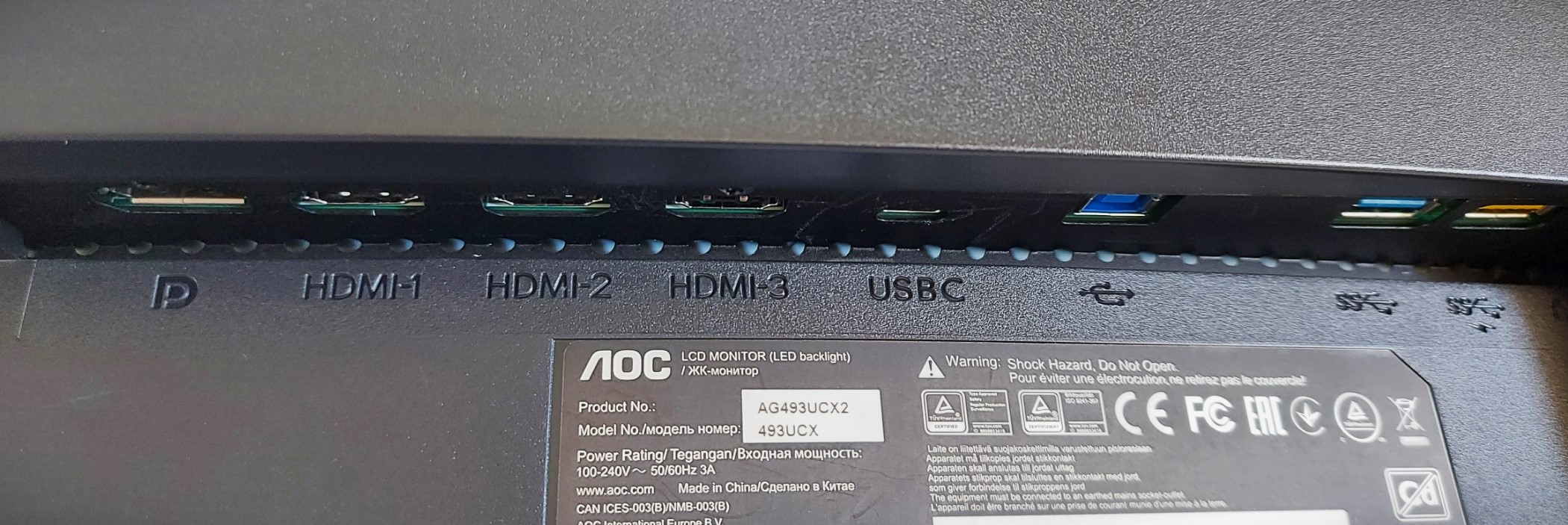
Given the issues I had with HDMI-connected consoles, I’d have preferred they kept two DisplayPorts and two HDMIs, though in reality users are more likely to have additional devices with HDMI outputs rather than a second desktop with DP.
The monitor has a built-in automatic KVM switch, which worked as expected in our testing. If you have two devices in PBP mode, it defaults to the main source (displayed on the left half of the screen). To change which device is controlled by the peripherals, you can either switch the main and sub source or go into OSD Setup and change the USB Selection manually.
To use KVM on more than one device, you’ll need to use USB-C on one device and the USB upstream on the other. Without a USB-C connection, you’ll need to swap the upstream cable between PCs.
Supported Resolutions
The AOC AGON AG493UCX supports the following maximum resolutions:
HDMI: 5120 x 1440 @ 75 Hz | 3840 x 1080 @ 120 Hz | 2560 x 1440 @ 120 Hz in PBP mode
DP: 5120 x 1440 @ 165 Hz | 2560×1440 @ 120Hz in PBP mode
USB-C: 5120 x 1440 @ 120Hz | 2560×1440 @ 120 Hz in PBP mode*
*If the USB setting on the monitor is set to USB 3.2, the max refresh of USB-C is limited to 5120×1440 @ 60Hz or 2560×1440 @ 60Hz in PBP.
In addition to the refresh rate limitations, the bit depth is also restricted for everything but DisplayPort connections. This is a 10bit panel (8bit+FRC), but that bit depth is only available at 60Hz via HDMI, and USB-C only supports 8bit colour.
Another annoyance was when I connected my laptop as an additional display in PBP. When using USB-C (DP alt mode) it letterboxed the image, shrinking it into the centre of the screen. I manually changed the laptop to 2560×1440 (and 1080p), but this scaled the image down to a shrunken box, rendering USB-C useless in PBP. I connected my laptop via HDMI 2.0, which displayed with the correct scaling, but this stopped the automatic KVM switchover. It’s not a deal-breaker, but it’s another area where I feel AOC should have improved the user experience.
As with the old model, the AG493UCX2 is excellent when used with DisplayPort, but there are too many limitations if that is not going to be your primary display connection.
Display Quality
The picture quality of the AG493UCX2 is decent out of the box, but you’ll need to make a few tweaks to get it looking its best. sRGB display colour is accurate, but the default gamma is inaccurate. Changing to Gamma 2 was closer to the 2.2 curve but still required calibration to reach an acceptable level of accuracy.

Brightness and black levels are very good, but they were significantly better after calibration. It’s a shame that it took calibration to get the best from this display – brightness rose from 555 to 629 cd/m² and contrast increased from 2370:1 to 2979:1.
The usual complement of gaming features and presets are present on the AG493UCX, including black level adjustment, an on-screen crosshair overlay and various game modes. Although they can be advantageous for things like esports titles, the subpar response and motion blur mean those kinds of gamers are unlikely to choose this panel, rendering it largely defunct.
On a positive note, PBP (picture by picture) mode now lets you adjust brightness and contrast without having to switch to single-source mode to make adjustments. It’s a very welcome and significant improvement.
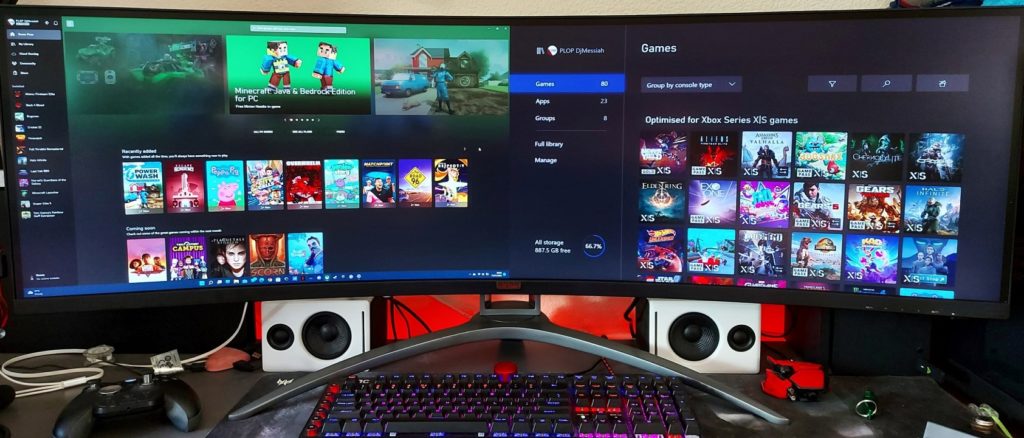
Brightness, contrast and colour
Peak brightness was impressively high, measuring around 555 cd/m², which is above the common average of 300-350 cd/m², delivering a bright image that’s clearly visible in a very brightly lit room. This is further bolstered by the low black level of 0.23 cd/m², with a resulting contrast ratio of 2370:1.

VA panels typically have great contrast, however, the AG493UCX2 has an advertised contrast of 3000:1. It wasn’t until I calibrated the display that I was able to reach this figure, which reinforces my opinion that the factory calibration could have been much better. It should be noted that the previous model had much better contrast, so this could just be a one-off, but I can only review based on what’s in front of me.

The warm colour temperature preset is closest to 6500K at 7400K, but it’s a little cooler than I prefer. Colour accuracy is good, however, with an average DeltaE of 0.68 (0.44 calibrated) in sRGB mode (brightness cannot be adjusted in sRGB mode, but the default is a usable 218 cd/m²). The saturation is excellent, with no over or under-saturation of colours, giving images a very natural appearance. I’ve been using a lot of displays recently with massive gamut coverage, so it did look a little flat at first, but once I had time to adjust I came to appreciate the more natural appearance.
Gamut coverage
The panel in the AOC AGON AG493UCX2 has 10bit colour depth (8bit+frc), allowing it to display up to 1.07 billion colours, with decent gamut coverage:
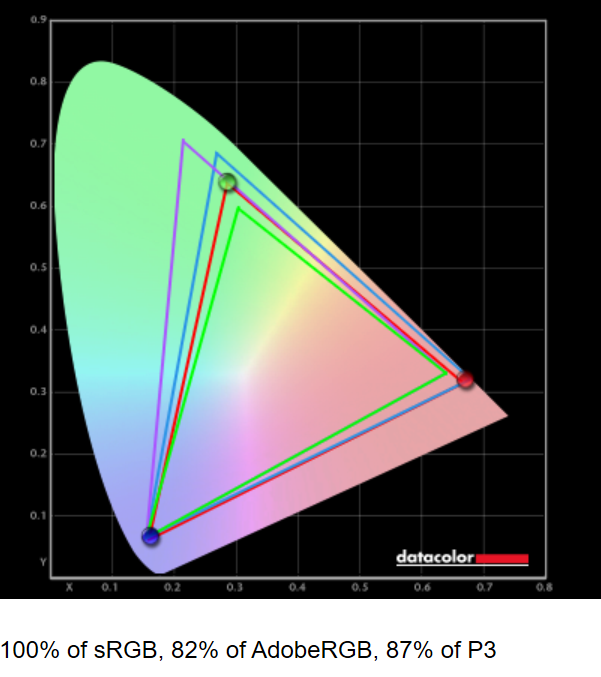
- sRGB has 100% coverage with a volume of 120.1%
- AdobeRGB has 82% coverage with a volume of 82.7%
- DCI-P3 has 87% coverage with a volume of 87.1%.
*Coverage is how much of the gamut is covered, whilst volume includes any colour that extends beyond the defined gamut.
Colour saturation and coverage aren’t quite at the heady heights of AOC’s AGON PRO range, but just a few years ago these would be premium display levels. You get full sRGB coverage and reasonable DCI-P3 coverage which gives good colour in HDR content. AdobeRGB coverage could be higher, but the AG493UCX2 is primarily a gaming monitor, so this isn’t a concern.
Although the results on paper aren’t as high as other displays we’ve tested, I was still impressed with the vibrancy of colour, especially at lower brightness levels.
I’m not going to spend too long on the HDR performance, as this is only an HDR400 display, so there’s no local dimming and you don’t get the full HDR experience. Peak brightness hits 650 cd/m² with good contrast, so it’s superior to any IPS panel for HDR400, and the respectable DCI-P3 coverage allows the AG493UCX2 to produce some stunning colours. AOC has reigned in its HDR modes, too – HDR game mode on the old model used to oversaturate colours to a massive degree, but here they are bright without being blown out. DisplayHDR mode is more natural, but without as much brightness overall. In my opinion, the SDR image looks better across the board, so I wouldn’t recommend this if you’re heavily invested in HDR.
Viewing angles and uniformity
Panel uniformity is better than I expected for a display of this size. There are a few hotspots where brightness and contrast exceed the nominal limits, but for the most part, it’s in the green.

Colours do have a tendency to become washed out when viewed at an angle, which can occur if you’re close to the screen or sitting off-centre. It’s less significant when gaming, as this is usually in your peripheral vision, but when I was editing images at the side of the screen I had to move in front of the picture to make sure it was accurate.
VA glow is minimal, and light bleed is visible but not distracting. It’s far better than most IPS displays, and about average for a VA panel.
Response
Ghosting is a significant issue on this display, along with black smearing. Although that’s to be expected of a VA panel, it can be very pronounced and distracting.
Setting overdrive to weak alleviated some of the ghosting when viewing light objects against light backgrounds, but the darker the background gets, the worse the ghosting becomes. Increasing the overdrive to medium or strong introduced inverse ghosting and sizeable coronas, so you’re stuck with significant blurring during fast motion.
Panel response also left a lot to be desired, measuring in at over 40ms on extreme black-white-black transitions.
As such, this display is not suited to competitive gaming where fast response is key, and if you’re particularly sensitive to ghosting this probably isn’t the display for you. I thoroughly enjoyed playing racing games and sims on this monitor, though, and scenic AAA games were an absolute delight. I would highly recommend you carefully consider the kind of games you are interested in playing if you’re considering purchasing this monitor.
Pricing and availability
At the time of writing, the AGON AG493UCX2 is available for £979.49 at various retailers. This is nearly £100 more than the previous model, bringing it closer to the industry-leading Samsung Odyssey G9. There’s a lot more competition this time around, with many comparable monitors costing significantly less.
Summary
If you are in the market for a super-ultrawide display, the massive AOC Agon AG493UCX is worthy of making the shortlist. It’s a great alternative to having a dual monitor setup, and super-ultrawide gaming is incredible.
Although this is still an improvement over the previous model, a lot of minor niggles remain, which when added together make this harder to recommend. Source switching and startup are painfully slow, motion handling isn’t great, and you only really get the best out of this monitor over DisplayPort, which stops this being the one screen to rule them all.
Even though I had a lot of problems, I still loved using this gargantuan display. It’s so close to being excellent, but it falls short in too many areas. If you can find a good deal this could be a great choice, especially if you will be using DisplayPort as your primary connection, but I’d compare this review with others before pulling the trigger to make sure this is the right choice for you.

